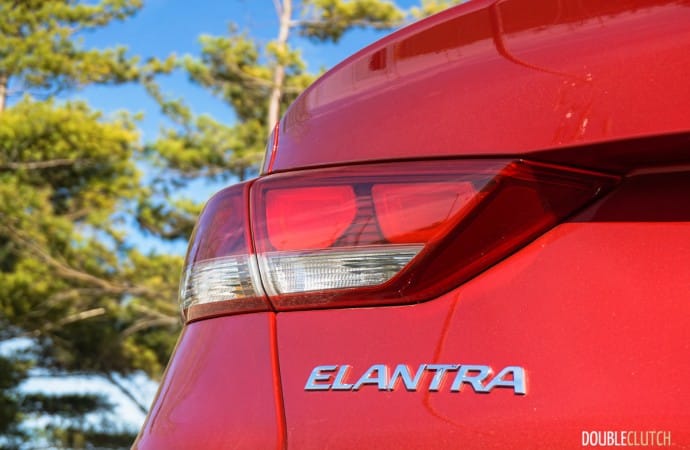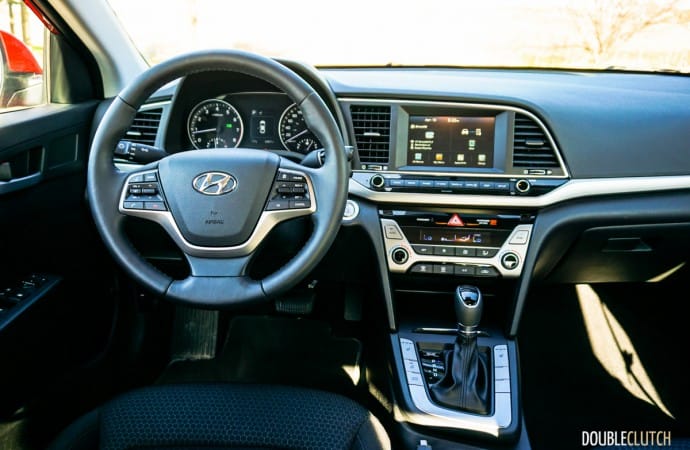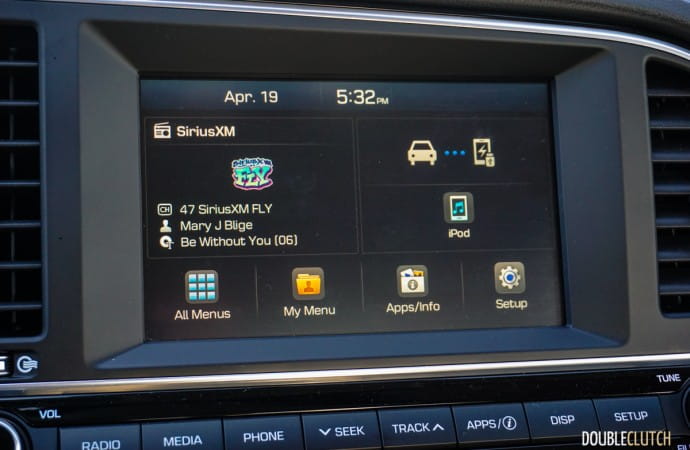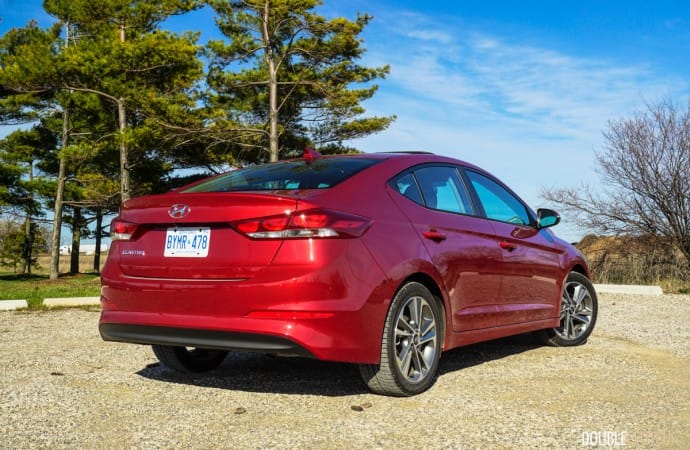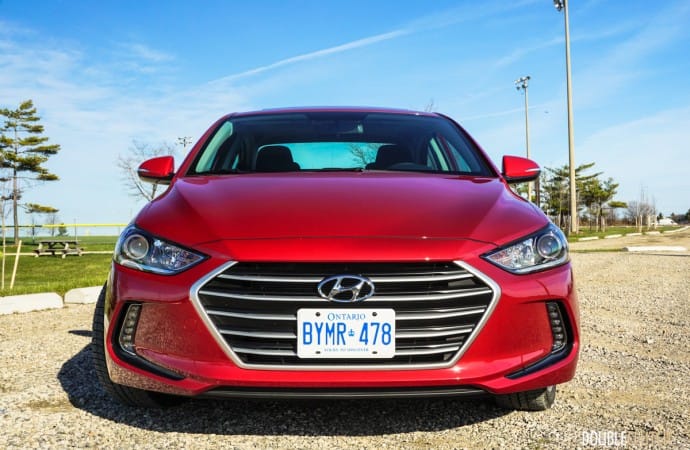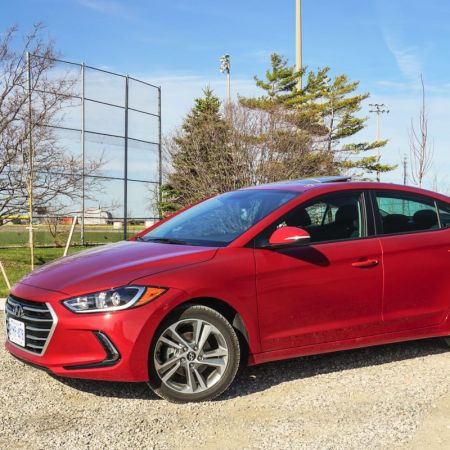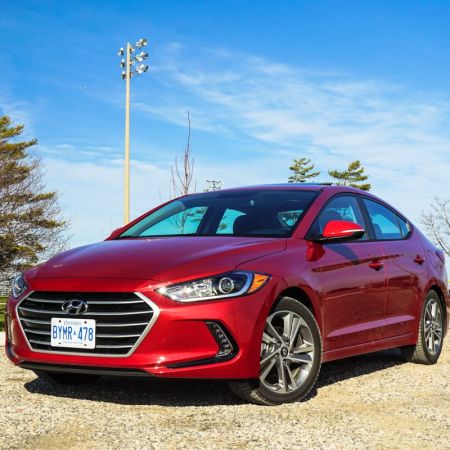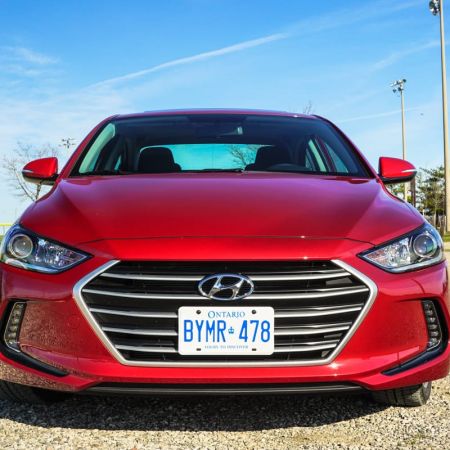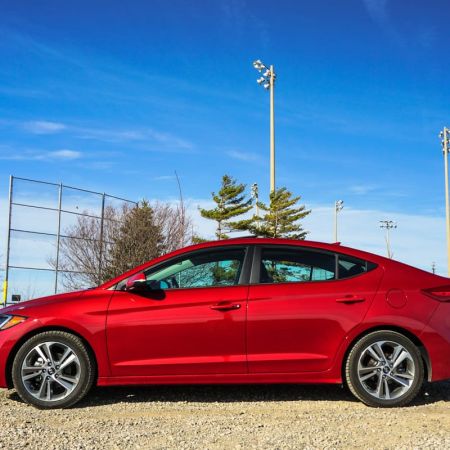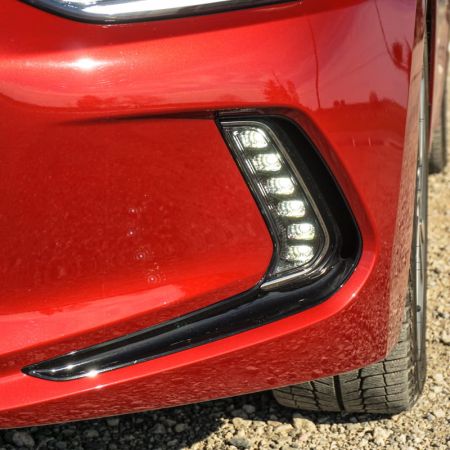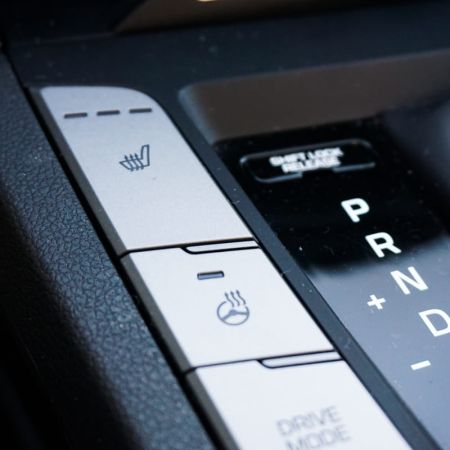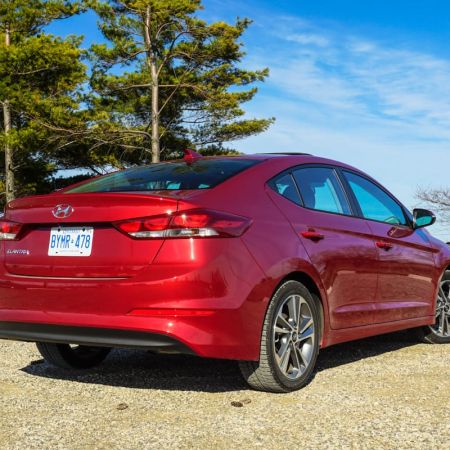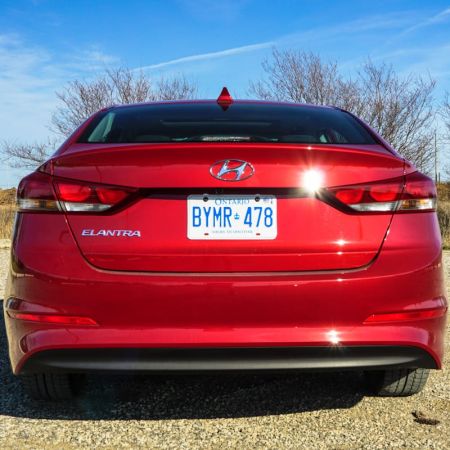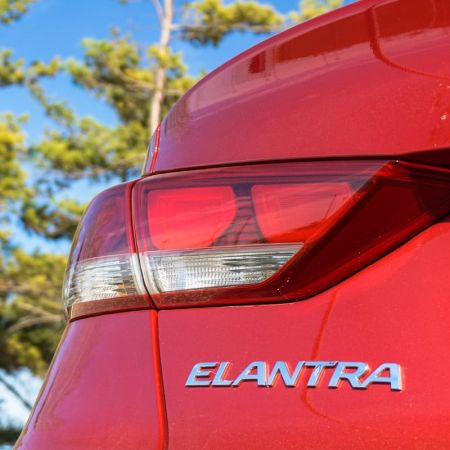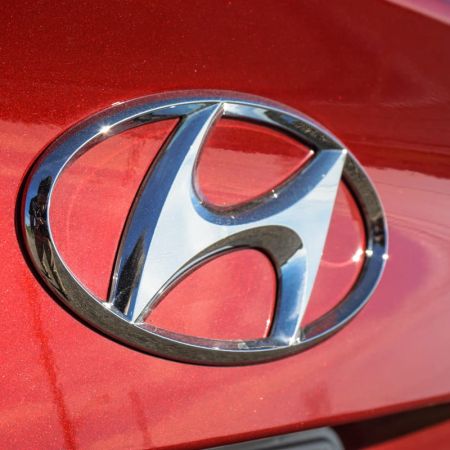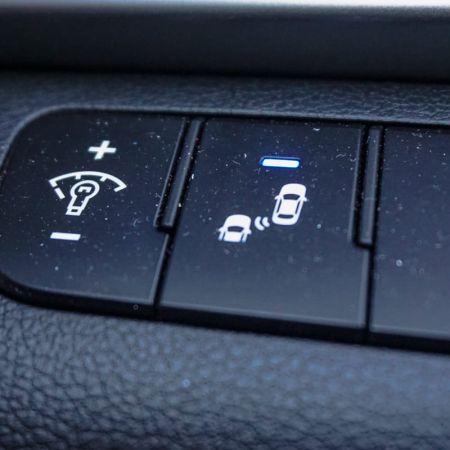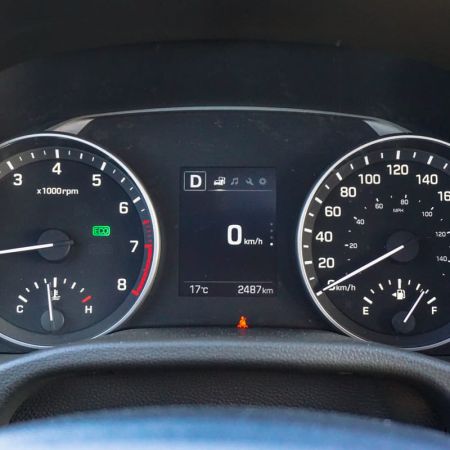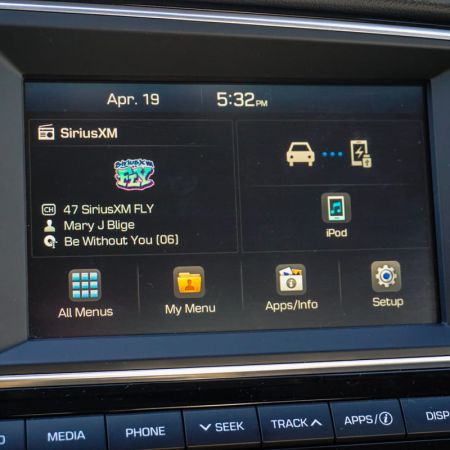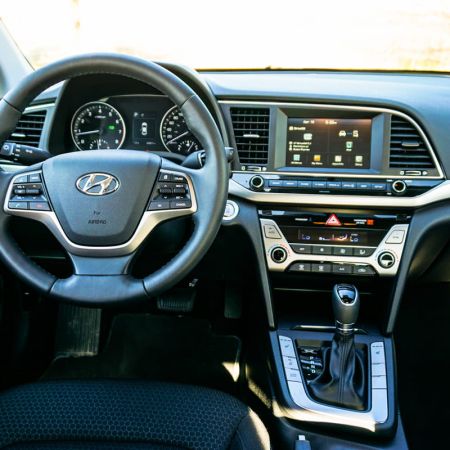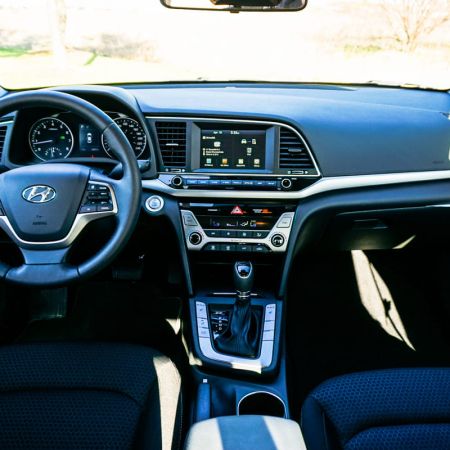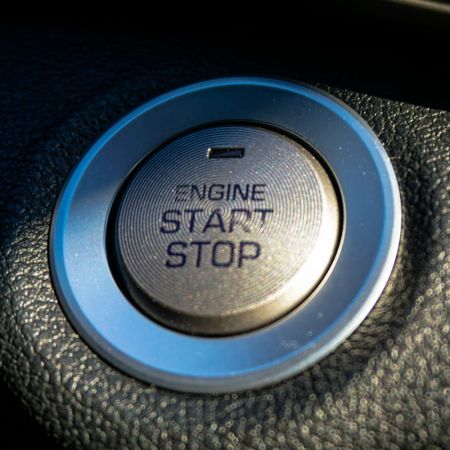In 2010, Hyundai debuted the fifth-generation Elantra, a game changer for the brand in the compact segment. For the first time ever, the Elantra was more than a forgettable Korean compact with average dependability and bland styling. I was a huge fan of that previous-generation car, because it reflected Hyundai’s taking a risk and trying to sell an aggressively styled car in an otherwise uninteresting class. This year marks the premiere of the sixth-generation model, and we were pleased to put one through the ringer for a week. Our tester was the 2017 Hyundai Elantra GLS, speculated to be the second most popular trim level sold in Canada (after the GL).
The sporty and out-of-the-box design of the previous generation Elantra helped it develop its own image among its rivals, and also did a great deal to improve the car’s reputation. This latest model is styled a bit more conservatively, and isn’t quite as distinctive as the previous one. Representing an evolution similar to that of the new Sonata (reviewed here), the new Elantra has large LED daytime running lights, a similar profile as the outgoing car, and the large open-mouth grille that Hyundai is implementing across the lineup. The overall profile is similar to that of the old car, and it’s the perfect development in my eyes. Our GLS test vehicle was riding on 17” aluminum wheels, a very stylish touch.
The interior of the new Elantra is what surprised me the most. The current Mazda3 (reviewed here) is a car I hold to a very high standard, and that’s because its interior is easily at the top of the compact lineup. Hyundai has one-upped it though – there’s a 7-inch touchscreen integrated nicely into the dash. It’s not tacked on top like the Mazda, and the system is easy to use, unlike the new Honda Civic (reviewed here). The dash and center console are nicely laid out and the amount of cheap-feeling plastics is minimal – another rarity in this segment.
Within the cabin, the driving position is pretty good, and visibility all around is adequate. The beltline is pretty low, and there isn’t too much of a rake to the windshield, but the slope of the rear window does provide some distortion, which could be a bit confusing when gauging distance on the highway. The driver’s seat is manually adjustable, but provides enough travel in every direction to keep most drivers comfortable. At 6’1 with longer legs, I was quickly able to find my ideal position – bonus points to the tilt/telescopic wheel.
The 7” infotainment screen is Hyundai’s standard-issue setup. It provides decent functionality but is definitely getting a bit long in the tooth. Mazda’s HMI setup and Honda’s latest iteration in the Civic are both new within the last couple of years, so this holds the Hyundai back a little bit. On the positive side though, the system is lightning quick and very responsive to touch inputs. There are also actual physical buttons for major commands, and browsing lengthy playlists and huge libraries on an iPod is made effortless. A bonus is capability of Android Auto. Overall, the system’s graphics may be more dated than those in the Civic, but it destroys it in everyday usability.
In Canada, the base Elantra L is priced at $15,999 and comes with remote entry, heated seats, and projector headlights at this entry price. Most Canadians will opt for the mid-range GL ($20,349), which adds the 7.0” touchscreen, heated steering wheel, heated seats, Bluetooth, and the majority of features taken for granted in a new vehicle these days. Our GLS adds a power sunroof, 17” alloys, proximity keyless entry, and heated rear seats. Hyundai ensures that blind spot monitoring, stability control, and ABS is standard on this model, as well as four-wheel disc brakes. Priced at a competitive $22,699, this is a very well equipped car.
Powering the new Elantra is Hyundai’s new “Nu” 2.0L Atkinson-cycle inline four-cylinder engine, surprisingly without direct injection. This is interesting because Hyundai/Kia have been strong advocates of DI setups in the past few years. The motor is impeccably smooth and delivers 147 horsepower (at 6,200RPM) and 132 lb-ft of torque (at 4,500RPM) in this application, unremarkable numbers. These numbers aren’t a huge improvement over the last car, but the difference is significantly better fuel economy and more refinement. Throttle response is adequate, the six-speed automatic is a welcomed inclusion (as opposed to a CVT), and the engine has very good reflexes.
Ride quality is nothing to write home about, but the Elantra takes on the 400-series highway system fairly well. There is still a Macpherson strut setup in front and the front swaybar diameter is still identical, at 22mm. The rear dampers have been improved for better handling and a smoother ride, which is noticeable. Hyundai has been advertising “Superstructure”, which is what they call a new standard for rigidity. This involves use of “advanced” high-strength steel improving ride quality, handling, safety, and interior quietness. The fact that the Elantra is noticeably quieter than its predecessors became immediately obvious on our first highway run with it.
We tried all three of the drive modes, and found “Eco” to be a good everyday setting. The throttle is numbed a little bit, and the transmission short-shifts, but the fuel savings in this setting is undeniable. Hyundai suggests 8.3L/100km city and 6.4L/100km highway for the automatic transmission Elantra, and a combined rating of 7.4L/100km. This doesn’t sound particularly good, but we managed to blow these numbers out of the water without even trying to be conservative. On the highway, our Elantra GLS averaged 5.8L/100km all day long, and the combined average never got any worse than 6.5L/100km, even after extensive commuting in rush hour traffic.
When you consider that the Elantra is offered across the globe with at least five engine choices and three transmissions (including a seven-speed dual-clutch in some markets), it becomes pretty evident that Canada got the short end of the stick. In the past two years, I can personally think of four readers and/or friends we recommended into a manual-transmission Elantra because of how much value the car presented. Now though, Hyundai Canada only offers the three-pedal alternative on the base model Elantra L. Want air conditioning and a stick? You’re out of luck for now, but we’ve been told that this will be changing in the coming months.
The only huge annoyance I had with the Elantra was the abnormally light steering. Of course, it’s to be understood that the vast majority of Elantra buyers are buying the car for functionality and practicality purposes rather than a frivolous “fun” purchase. Non-car people will find the little Hyundai’s steering to be effortless, but enthusiasts will tout it as lifeless and lacking in feedback. Parking lot and city maneuverability is on point, but highway speeds require considerable overcorrection. The car handles well enough, but the wheel just doesn’t inspire much confidence.
Seeing all of the awards it has won in the past months, the new Honda Civic seems to be on a media pedestal. Rightfully so, because it’s an exquisite car, but there are other alternatives that are just as good. The 2017 Hyundai Elantra GLS is the underdog in the compact class – it’s up there with the Mazda3 as my current favourite. Those wanting to row their own gears on a highly optioned car may want to check out the Mazda, but that doesn’t represent the Canadian car-buying public. The new Hyundai Elantra is a stylish, efficient sedan that’s one of the easiest cars to live with year-round. The latest iteration builds on this winning formula and adds a bunch of goodies that Canadians will thoroughly appreciate.

